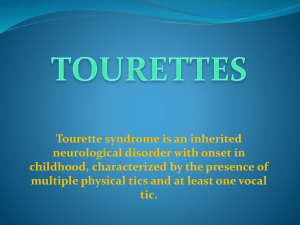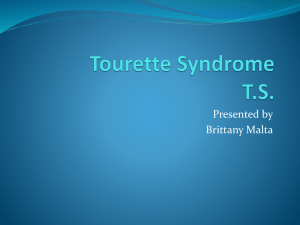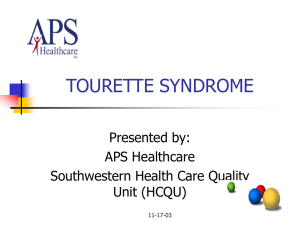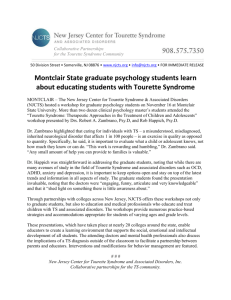Tourette's Syndrome
advertisement
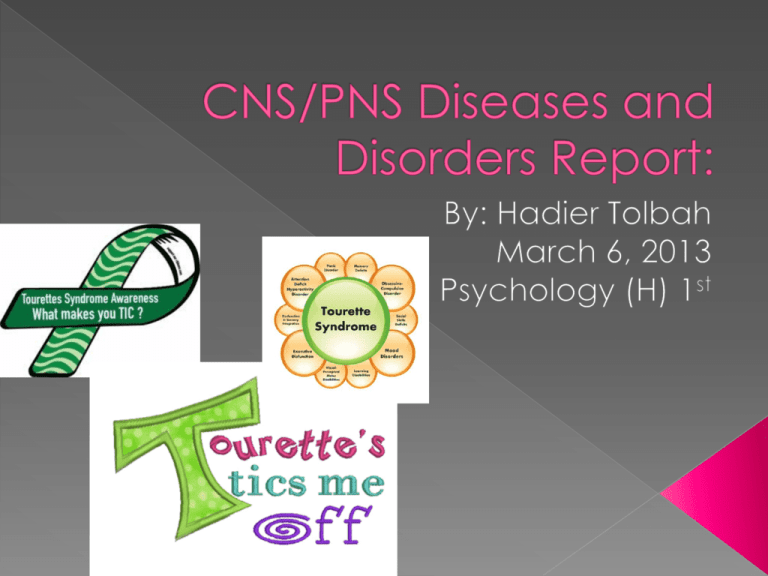
Tourettes Syndrome Cause: Tourettes Syndrome is unknown. Current research points to abnormalities in certain brain regions. How its transmitted: Tourettes Syndrome is a neurological disorder that causes repeated, involuntary physical tics and vocal outbursts. Tourettes can be caused by genetics or environmental factors. About 200,000 people have been diagnosed with severe symptoms of Tourettes syndrome. Just about 6.5% in the United States (the is not a specific race). Tourettes affects the part of the brain that is responsible for the sensory and motor signals to the cerebral cortex, which is called the thalamus. The thalamus is a limbic structure and its located under the cerebral cortex. Simple Tics: Complex Tics: * eye blinking * touching the nose * head jerking * shoulder shrugging * yelling * barking * hiccupping * touching other people * smelling objects * obscene gesturing * flapping arms * using vulgar/swear words Although there is no cure for Tourrettes Syndrome, the condition in many individuals improves in the late teens and early 20s. Individuals with Tourettes Syndrome have a normal life expectancy. http://www.youtube.com/wa tch?feature=player_detailpa ge&v=HylTFT6gVRU There is no cure or treatment for Tourrettes Syndrome, but there are effective medications for those whose symptoms interfere with functioning (ex: haloperidol and pimozide). Steve Wallace There are several famous people who have Tourettes and set a shinning example of what is possible for other people with this disorder. David Beckham Tim Howard Howie Mandel NINDS – National Institutes of Health Mayo Clinic Pediatric Tourette Syndrome Treatment & Management National Research Center Tourette Syndrome Clinic Andres, L. M. (2002). Tourette Syndrome. In D. S. Blanchfield & J. L. Longe (Eds.), The Gale Encyclopedia of Medicine (2nd ed., Vol. 5, pp. 3341-3345). Detroit: Gale. Retrieved from http://go.galegroup.com/ps/i.do?id=GALE%7CCX3405601582&v =2.1&u=cary81451&it=r&p=GPS&sw=w Eubanks, S. R. (2005). Tourette Syndrome. In B. Narins (Ed.), The Gale Encyclopedia of Genetic Disorders (2nd ed., Vol. 2, pp. 1265-1270). Detroit: Gale. Retrieved from http://go.galegroup.com/ps/i.do?id=GALE%7CCX3451500421&v =2.1&u=cary81451&it=r&p=GPS&sw=w NINDS Tourette syndrome information page. (2011). In Pamphlet by: National Institute of Neurological Disorders and Stroke. National Institute of Neurological Disorders and Stroke. Retrieved from http://go.galegroup.com/ps/i.do?id=GALE%7CA267027019& v=2.1&u=cary81451&it=r&p=GPS&sw=w
